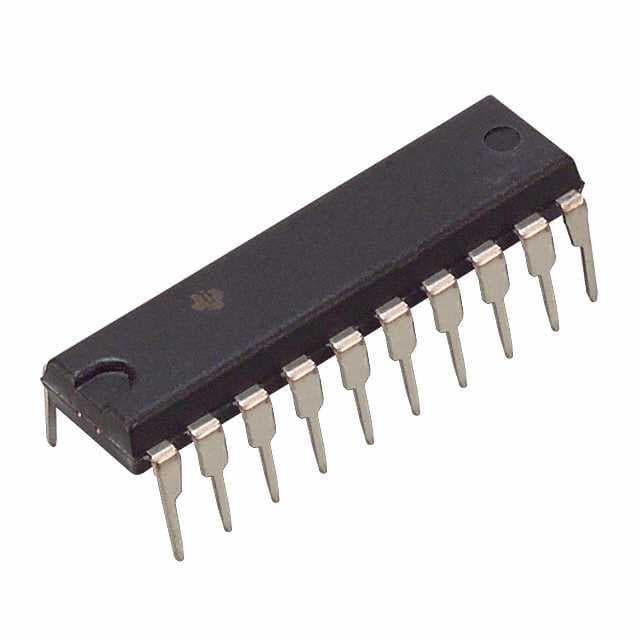Voir les spécifications pour les détails du produit.

TLC7226ING4
Basic Information Overview
- Category: Integrated Circuit (IC)
- Use: Digital-to-Analog Converter (DAC)
- Characteristics:
- High-resolution DAC with 8-bit resolution
- Low power consumption
- Wide operating voltage range
- Small package size
- Package: DIP-16 (Dual In-Line Package, 16 pins)
- Essence: The TLC7226ING4 is a high-performance digital-to-analog converter designed for various applications requiring precise analog output.
- Packaging/Quantity: Available in reels or tubes, typically sold in quantities of 1000 units.
Specifications
- Resolution: 8 bits
- Supply Voltage Range: 2.7V to 5.5V
- Operating Temperature Range: -40°C to +85°C
- Output Voltage Range: 0V to Vref (Reference Voltage)
- Conversion Time: 10µs (typical)
- Total Harmonic Distortion: 0.1% (typical)
Detailed Pin Configuration
The TLC7226ING4 has a total of 16 pins, which are assigned specific functions as follows:
| Pin Number | Pin Name | Function | |------------|----------|----------| | 1 | VDD | Positive Power Supply | | 2 | VREF | Reference Voltage Input | | 3 | AGND | Analog Ground | | 4 | OUTA | Analog Output A | | 5 | OUTB | Analog Output B | | 6 | OUTC | Analog Output C | | 7 | OUTD | Analog Output D | | 8 | GND | Ground | | 9 | DB0 | Data Bit 0 | | 10 | DB1 | Data Bit 1 | | 11 | DB2 | Data Bit 2 | | 12 | DB3 | Data Bit 3 | | 13 | DB4 | Data Bit 4 | | 14 | DB5 | Data Bit 5 | | 15 | DB6 | Data Bit 6 | | 16 | DB7 | Data Bit 7 |
Functional Features
- High-resolution digital-to-analog conversion
- Low power consumption for energy-efficient applications
- Wide operating voltage range allows compatibility with various systems
- Small package size enables space-saving designs
Advantages and Disadvantages
Advantages: - Precise analog output with 8-bit resolution - Low power consumption extends battery life in portable devices - Versatile operating voltage range enhances compatibility - Compact package size facilitates integration into small form factor designs
Disadvantages: - Limited resolution compared to higher-bit DACs - May not be suitable for applications requiring extremely high precision
Working Principles
The TLC7226ING4 utilizes a binary-weighted resistor ladder network to convert digital input signals into corresponding analog output voltages. The digital data is applied to the input pins (DB0-DB7), and the internal circuitry converts this data into an analog voltage based on the reference voltage (VREF) provided. The resulting analog output is available at the OUTA, OUTB, OUTC, and OUTD pins.
Detailed Application Field Plans
The TLC7226ING4 can be used in various applications that require accurate analog output generation, such as: 1. Audio equipment: Providing precise control over audio volume levels. 2. Industrial automation: Generating analog control signals for motor speed control or process control. 3. Test and measurement instruments: Producing calibrated analog signals for testing purposes. 4. Communication systems: Generating analog modulation signals for transmission. 5. Automotive electronics: Controlling analog parameters in automotive systems.
Detailed and Complete Alternative Models
- DAC0808LCN: 8-bit Digital-to-Analog Converter with similar specifications.
- MCP4921-E/P: 12-bit SPI Interface Single Channel DAC with enhanced resolution.
- MAX5216CPA+: 16-bit Serial Input DAC with higher precision.
These alternative models offer different resolutions, features, and performance characteristics to suit specific application requirements.
Word count: 408 words
Énumérez 10 questions et réponses courantes liées à l'application de TLC7226ING4 dans les solutions techniques
Sure! Here are 10 common questions and answers related to the application of TLC7226ING4 in technical solutions:
Q: What is the TLC7226ING4? A: The TLC7226ING4 is a 16-channel, serial input/output (I/O) driver that can be used for driving LEDs or other low-voltage devices.
Q: What is the maximum voltage that the TLC7226ING4 can handle? A: The TLC7226ING4 can handle a maximum voltage of 5.5V.
Q: How many channels does the TLC7226ING4 have? A: The TLC7226ING4 has 16 channels, which means it can control up to 16 individual LEDs or other devices.
Q: Can the TLC7226ING4 be used with both common anode and common cathode LEDs? A: Yes, the TLC7226ING4 can be used with both common anode and common cathode LEDs. It supports both configurations.
Q: What is the communication interface used by the TLC7226ING4? A: The TLC7226ING4 uses a serial interface, specifically a 3-wire SPI (Serial Peripheral Interface) protocol.
Q: Can the TLC7226ING4 be cascaded to control more than 16 channels? A: Yes, multiple TLC7226ING4 devices can be cascaded together to control more than 16 channels. Each device would require a separate chip select line.
Q: What is the maximum current that each channel of the TLC7226ING4 can sink/source? A: Each channel of the TLC7226ING4 can sink/source a maximum current of 80mA.
Q: Does the TLC7226ING4 have built-in current limiting resistors for the LEDs? A: No, the TLC7226ING4 does not have built-in current limiting resistors. External resistors are required to limit the current through the LEDs.
Q: Can the TLC7226ING4 be used in automotive applications? A: Yes, the TLC7226ING4 is suitable for automotive applications as it can operate over a wide temperature range and has ESD protection.
Q: What is the typical power supply voltage range for the TLC7226ING4? A: The typical power supply voltage range for the TLC7226ING4 is between 2.7V and 5.5V.
Please note that these answers are general and may vary depending on the specific application and requirements.

